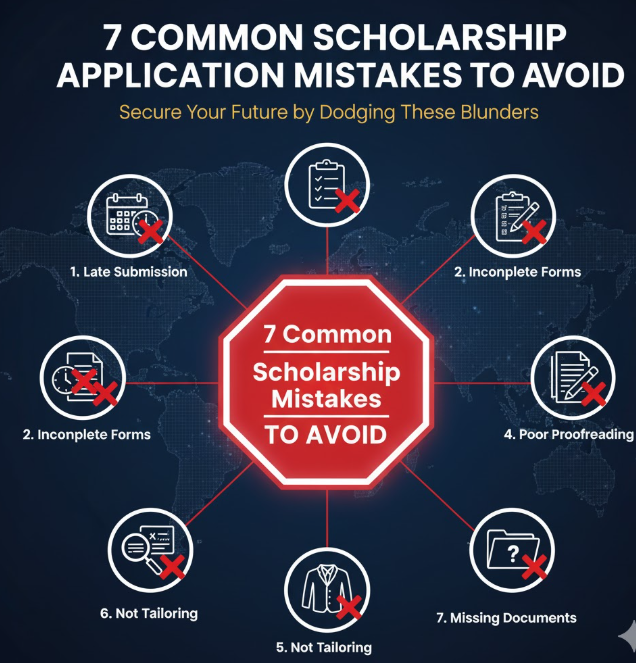It’s a dream come true, right? Free money that you never have to pay back! But there’s one catch: every year, thousands of students lose scholarship money — not because they’re unqualified, but because they make avoidable errors on their applications.
Picture scholarship applications as a video game. You may be all that, but if you don’t play by the rules or cut corners, you’ll be a loser at the starting gate. The good news? Most errors are easy to avoid once you’re aware of them.
Read through the seven biggest mistakes students make when applying for scholarships. Whether you’re a high school junior just beginning your search for scholarships or a senior who is filling out his 10th application, this piece of writing will help you avoid all those common road-blocks and boost up your chances of getting that scholarship money.
Mistake #1: Not Taking Time to Plan and Organize
In a nutshell, waiting until the last minute.
Here’s a scenario that plays out all too often: You come across an incredible scholarship that is tailor-made for you. You could win $5,000 and you qualify. You’re excited and you bookmark the page thinking, “I’ll do this later.” And then you get busy with school work, sports practice and hanging out with friends. And then you blink and the deadline’s tomorrow and at 11:59 p.m. you’re throwing together an application left and right.
Sound familiar?
The biggest mistake students make is probably rushing your applications. Here’s what bad things happen when you procrastinate:
Why Last-Minute Applications Fail:
- You don’t have time to write an intelligent essay
- You can’t ask for recommendation letters from teachers (they need 2-3 weeks advance notice)
- You might overlook an application’s crucial features
- You cannot correct errors or better your response
- This can put you right up against deadlines, and then technical troubles (like websites crashing) can cause you to miss the deadline altogether
The Better Approach:
Begin work on scholarship application at least three weeks before the deadline. Make a calendar or spreadsheet of all your deadlines. Create phone reminders for a month before, two weeks before and one week before every deadline.
Again, break the application into pieces. For example:
- Week 1: Collect all necessary documents and begin your essay
- Week 2: Complete the essay and request your letters of recommendation
- Week 3: Review, refine and submit
That way, you’re not stressed and can turn in your best work.
Mistake #2: Ignoring the Instructions
The reason why scholarship committees give you specific instructions is for a reason. When you disregard it, you are essentially communicating to them that you don’t pay attention to the details or follow directions. It’s not the image you want to give.
Common Instruction Mistakes:
Students often mess up by:
- Writing 800 words when you are supposed to write 500 words
- Uploading a PDF when they were looking for a Word document
- Failure to submit a document needed for consideration, such as a transcript
- Omitting to respond to an essay question
- Using the wrong font or format
Here’s an actual example: One scholarship asked students to write their student ID number in the top right corner of all pages. Sounds simple, right? But 40 percent of applicants neglected to take this step, thereby leading their application to be immediately rejected.
How to Avoid This Mistake:
Make a checklist for every scholarship application. Read the full application requirements first, before you start filling anything out. Highlight or underline important rules. Then just check it off when you are done.
Now, before it’s too late and it all goes up in smoke, work through the instructions once again – you never know! It may feel redundant, but if you can spend five minutes double-checking, that might be the line between receiving $5,000 and getting rejected.
Mistake #3: Spamming With Generic Copy-Paste Applications
This is basically like flinging spaghetti against the wall and hoping something sticks.
Suppose you’re hosting a birthday party and want to invite some of your friends to it. Most write sweet, personal messages in your birthday card. But a friend who says only “Happy Birthday” on each of their multitude of cards for anyone is just rude. Which would be more meaningful to you?
Applications for scholarships operate the same way. Scholarship committees can smell a generic essay a mile away.
Why Generic Applications Don’t Work:
By sending a cookie-cutter essay and application, you are taking away the opportunity to explain why YOU deserve THIS scholarship. Scholarships are worth a varying amount and have different criteria. A scholarship for would-be doctors wants to hear other things than does a scholarship founded for artists or athletes.
Here’s Why Applications Start to Feel Cookie-Cutter:
- Saying things like “I’m applying for this scholarship” without specifying which one
- Failing to name the donor or scholarship-granting body
- Providing responses that could apply to any scholarship
- Failure to tie your goals to scholarship mission
- Recycling the same essay without editing it
How to Personalize Your Applications:
Research each scholarship before applying. Look up:
- Who endowed the scholarship, and why?
- What type of students they want to help
- What they value or believe in
Next, personalize your essay to tie your story to their mission. For instance, if you are applying for a scholarship in memory of a teacher who was passionate about science, explain how your passion for science and aspirations were ignited by that teacher.
You can recycle portions of your essays for other applications, but just make sure to tailor them specifically to the scholarship and program you’re applying for. Vary the introduction, add in pertinent information and ensure it feels specific to that potential assignment.
Mistake #4: Sloppy, Error-Filled Writing in the Essays
Your essay is generally the most important part of your scholarship application. It’s your opportunity to make your case and demonstrate why you’re deserving of the money. But if your essay is littered with spelling errors and grammatical issues, that’s going to grab more attention than the points you’re trying to make.
Just consider: If someone were giving away $10,000, would he or she give that money to an individual who didn’t take the time to proofread their essay?
Common Writing Mistakes:
- Typo errors (get the name of the scholarship right!)
- Grammatical errors such as “your” for “you’re”
- Endless run-on sentences that just stretch for days and keep stretching without any periods so they’re super hard to read
- Starting sentences with “and” or “but” too frequently
- Repetition of the same word
- Confusing sentences that don’t make sense
The Real Problem:
It is not just the errors themselves. Mistakes in your essay indicate that you don’t care enough to do your best work. The scholarship committee reasons: “If they can’t be bothered to edit such a simple essay, how serious are they about college?”
How to Submit Error-Free Essays:
Follow this editing process:
- Write your first draft without worrying about mistakes
- Wait at least 24 hours before editing (it makes it easier to see mistakes)
- Read it aloud to pick up odd sentences
- Use spell-check on your computer, but don’t rely on it completely
- Ask others to read it — parents, teachers, friends or a school counselor
- Read through it one last time before handing in
Pro tip: Read your essay aloud, backwards or sentence by sentence. This makes you focus on each line independently and can make it easier to see mistakes.
Mistake #5: Being Either Too Humble or Overly Boastful
The tone of your scholarship essay is crucial. Some students are overly humble and fail to tout their accomplishments. Others overshoot the mark in the other direction, verging on boastful.
The Too-Humble Approach:
Some students write things like:
- “I’m not really anything special, but…”
- “I’m likely not as awesome as one of the other candidates…”
- “I only had a 3.8 G.P.A., which is not good…”
This doesn’t work because the committee is asking, “What makes you so great?” They are looking for reasons to give YOU the money, not reasons to turn you down.
The Too-Boastful Approach:
On the other hand, some students write sentences like:
- “I’m the smartest kid in my school…”
- “I work harder than anybody…”
- “I’m the most entitled to this scholarship…”
This reads as arrogant and off-putting.
Finding the Right Balance:
The trick is to be confident and yet gracious. Share achievements and success stories with real examples and figures, but also show humility and appreciation.
Not this: “I don’t even know if I’m qualified for this…”
Instead, say: “I’ve worked really hard to keep a 3.8 GPA while I volunteer 10 hours per week at the local animal shelter.”
Rather than: “I am the smartest in my class…”
For example: “I feel proud to be the highest scoring person in AP Biology and that encouraged me to major in medicine.”
Discuss obstacles you have overcome, what you have learned from others and how the scholarship will help advance your contribution. This shows confidence without arrogance.
Mistake #6: Failing to Demonstrate Financial Need (When It’s Required)
Some scholarships are awarded based on merit (your achievements), while others are awarded based on financial need. If a scholarship inquires about financial need and you omit this section, or fail to explain why your family has extraordinary expenses, you’re shooting yourself in the foot.
Why Students Avoid This Topic:
There’s a lot of discomfort with money among students. It could be that your family is underwater, and you just don’t want to talk about it. Or perhaps, you feel that admitting you need help sounds weak.
But I’ve got a news flash for you: Scholarship committees WANT to assist students who require financial aid. That’s frequently the point of the scholarship.
What Committees Want to Know:
When they’re asking about financial need, what is it they’re trying to figure out?
- Why do you need this scholarship money
- What your family’s financial struggles are
- How this scholarship would make a difference in your education
- What you’ve already done to save for college (income, savings and so on)
How to Explain Financial Need:
Be straightforward and specific, but you don’t have to lay out every aspect of your family’s financial situation. Focus on the impact.
Good examples:
“I am the oldest of four children in a single-parent household and have witnessed firsthand my mother working two jobs to keep a roof over our head. I have about $2,000 saved from my part-time job at the grocery store, but I’m still going to need help to cover the full cost of tuition and books. A scholarship such as this is one that would enable me to work less and study more.”
“Drought has hit my family’s small farm over the past three years, which had a severe impact on our earnings. Nonetheless, I have managed a 4.0 GPA while putting in work every morning on the farm before school. This scholarship would stop me from having to take out huge loans for college and begin my career in debt.”
See how they’re up front about being strapped for cash while at the same time demonstrating work ethic and drive.

Mistake #7: Not Following Up & Re-Applying
Here is a mistake you make AFTER you apply: failing to follow up and giving up if you don’t win the first time.
The Follow-Up Mistake:
Don’t forget about the application after you hit “submit.” Some scholarships will get in touch with you if they need more information, but they might email you at an address you frequently ignore, or have their email go to your spam folder.
What You Should Do:
- Make sure they got it (many sites you applied to will send you an email confirmation)
- Add the scholarship committee’s email to your contacts so that it doesn’t end up in spam
- Keep an eye on your email for updates
- If they reveal that winners will be announced by a specific date, jot that down in your calendar
The “Giving Up” Mistake:
A lot of students put in for a handful of scholarships, don’t win any of them and then give up. This is a huge mistake! Scholarships are a numbers game. It’s a numbers game: The more you apply for, the better your odds.
Consider These Facts:
| Applications Submitted | Average Success Rate | Estimated Winnings |
|---|---|---|
| 1-3 scholarships | 10-15% | $0-$2,000 |
| 5-10 scholarships | 20-30% | $2,000-$5,000 |
| 15-20 scholarships | 40-50% | $5,000-$15,000 |
| 25+ scholarships | 60-70% | $15,000+ |
Note: These are only rough estimates, based on the averages when it comes to success rates for scholarships.
Keep Applying:
- Apply for scholarships throughout high school, not only your senior year
- Most scholarships allow you to reapply for the next year if you don’t win
- Even mini-scholarships ($500-$1,000) start to stack up fast
- There are scholarships with hardly any applicants, giving you an advantage
And if you don’t win, ask for feedback. Some scholarship committees will tell you why they didn’t pick you, which helps you make better applications down the line.
Creating Your Scholarship Success Plan
Now that you have learned the seven major mistakes, let’s plan for avoiding them:
Step 1: Get Organized Early
Establish a method to record scholarships at least 6-9 months before you need the money. Keep track, using a spreadsheet or app:
- Scholarship name and amount
- Deadline
- Requirements (essay, recommendations, transcript, etc.)
- Status (planning to submit)
Step 2: Create the Tools for Your Application
Create a master folder with:
- Your resume (or record of activities and accomplishments)
- Multiple drafts written by you about a variety of topics (challenges overcome, community service, career goals, etc.)
- A copy of your transcript
- A group of teachers and people who served as mentors to provide references
If prepped in advance, it’s faster to apply for several scholarships.
Step 3: Set a Weekly Scholarship Schedule
If hunting for scholarships were a part-time job, it would be paying above minimum wage. Spend 3-5 hours per week doing:
- Monday: Search for new scholarships
- Wednesday: Work on applications
- Friday: Application review and submission
Step 4: Get Feedback and Revise
Before submitting any application:
- Get at least two sets of eyes on your essay
- Have a parent or teacher read over your entire application
- Act on the feedback they are giving you
Step 5: Track Your Results and Learn to Improve
Keep notes about:
- What scholarships you did or didn’t win
- What worked well in your application
- What you can do better next time
Use them as a guide to improve your future applications.
Quick Reference: Scholarship Application Checklist
Print this checklist and apply it to every scholarship:
Before You Start:
- [ ] Read all instructions carefully
- [ ] Mark your calendar and set your alarms
- [ ] Verify that you meet all eligibility requirements
- [ ] Research the scholarship provider
While Completing the Application:
- [ ] Respond to all required questions
- [ ] Tailor your essay to this particular scholarship
- [ ] Follow word or character count limits
- [ ] Follow required format (font, spacing, file type)
- [ ] Include all documentation needed
Before You Submit:
- [ ] Spell-check and proofread everything
- [ ] Ask someone else to read your application
- [ ] Balance your tone between confident and humble
- [ ] Double-check that your information is accurate
- [ ] Make sure you have completed all questions
After You Submit:
- [ ] Confirm receipt of a submission acknowledgment
- [ ] Add the winner announcement date on your calendar
- [ ] Be on the lookout for emails from the committee
- [ ] Thank people who have provided recommendations for you
Real Success Stories
See how not making these mistakes helped the following students receive scholarships:
Maria’s Story:
Maria almost committed Mistake #1 (procrastinating) when she found a $10,000 scholarship that was due in two weeks. Rather than rush it, she opted to pass and concentrate on three other scholarships with later deadlines. Patiently, she won two of those scholarships for a combined $7,000. The following year, she applied early for the $10,000 scholarship and secured it.
Lesson: Sometimes it’s worth saying no to a scholarship and do a top job on others than spend too much time doing below par jobs.
James’s Story:
James was feeling frustrated by the rejections he kept receiving from scholarships until his English teacher showed him Mistake #3 (using generic applications). He was recycling the same essay for all scholarships. James began looking into each scholarship and customizing his applications. By the time he graduated high school, he’d won four scholarships worth $12,000.
Takeaway: Quality is more important than quantity. Better to apply in a personalized way 10 times than send out 50 copied and pasted applications.
Aisha’s Story:
Aisha was ashamed of her family’s financial status and avoided need-based scholarships (Mistake #6). When her school counselor persuaded her to apply and be truthful about her circumstances, she penned a powerful essay about holding two jobs while still achieving good grades. She earned five need-based scholarships totaling $20,000.
Takeaway: What you struggled with is what can help you the most when it comes to scholarships.
Frequently Asked Questions
How many scholarships should I apply for?
There’s no magic number, but most successful students apply for anywhere between 15 and 30 scholarships throughout high school. Concentrate on scholarships you’re eligible for, rather than submitting applications at random to hundreds. Instead of applying to a ton of scholarships quickly, it’s much better to submit quality applications for the right scholarships.
What if I’m not a straight A student with amazing accomplishments?
You don’t have to be a straight-A student to get scholarships. Most scholarships look for other attributes, such as community service, leadership, creativity, the ability to overcome challenges or some kind of special talent. Some are need-based or lottery-based. Scholarships are available for B-average students, so don’t sell yourself short.
Where can I find scholarships to apply for?
Start with your school counselor — he or she is aware of lesser-known local scholarships to which few students apply. Check websites like Fastweb, Scholarships.com, and Cappex. Ask your parents to check with their employers; many workplaces have scholarships for children of employees. Search for scholarships that match your interests, hobbies, heritage or career goals.
Can I use the same essay for different scholarships?
Yes, but there is a big catch: You have to customize it for every scholarship. Begin with a solid base essay and rework the intro, tweak examples to fit that scholarship’s criteria and transform the conclusion in order to resonate with that organization. Never send the same essay without any revisions.
What do I do if I miss a deadline?
Don’t panic! Take it as a lesson learned and push on. Create better reminders for your future deadlines. See if the scholarship is annual and reapply next year. Put your mental effort toward what’s ahead instead of what you’ve missed. There is no shortage of scholarships out there.
Do small scholarships ($500-$1,000) matter?
Absolutely! Small scholarships add up quickly. Five $500 scholarships equal $2,500. And small scholarships tend to have fewer applicants, so you’re more likely to win. They also help boost your confidence and application skills for bigger scholarships. Never dismiss a scholarship just because the amount won’t change your life.
If my family can afford college, should I apply for scholarships?
Yes! Scholarships can help offset the cost of a college education for students whose families have saved but don’t want their children to be saddled with debt when they graduate, or allow students to study abroad, buy supplies — or go on to graduate school. A lot of merit-based scholarships aren’t targeted at students with financial need.
How long does it take to fill out a quality scholarship application?
A few hours at first depending on how long it takes you to do research, write a first essay, and collect your materials (including all of them in one folder for ease). When you build a foundation of material to draw from, your subsequent applications could be as short as 1-2 hours. On some of the heavier applications with several essays or a creative project you could spend as long as two weeks. Always start at least several weeks ahead of the deadline.
What makes a scholarship essay stand out?
The best scholarship essays tell a specific story rather than listing accomplishments, show that you have grown and reflect on your experiences, explain how those experiences will tie into your future goals, showcase your personality and voice, and explain why this particular scholarship will help you make an impact. Avoid using common phrases and banal statements!
Can I ask my teacher for more than one recommendation letter?
Absolutely, just be considerate about their time. Ask early (a minimum of 3-4 weeks beforehand), give them all the information they need (deadline, your resume), offer to draft talking points about what you want mentioned, and don’t ask for more than 5-7 letters from one teacher in a given application season. Always send a thank-you note.
Conclusion: Your Scholarship Journey Begins Today
Looking for college scholarships can seem overwhelming at first, but don’t forget — every little bit helps! Even if you end up with just a handful of scholarships, you’re still thousands of dollars ahead than if you never applied at all.
The seven errors detailed in this article are absolutely preventable. You now know:
- Begin early — not at the 11th hour
- Follow instructions carefully
- Personalize every application
- Proofread and polish your essays
- Balance confidence with humility
- Explain when necessary why you have financial need
- Follow up and keep applying
The highest-earning scholarship recipients aren’t always the smartest or most gifted. They are the ones who apply diligently, learn from mistakes and don’t give up.
Your college aspirations are worth the effort. For every hour you spend applying for scholarships, you could be earning a couple hundred or thousand dollars. And the skills you’ll learn — writing, organization, meeting deadlines and telling your story — will serve you in college and beyond.
So start today. Find three scholarships for which you qualify, mark the deadlines on your calendar and start working on your first application. Stay clear of these seven common pitfalls and you’ll be vastly ahead of the game compared to most other applicants.
Your scholarship success is just one application away. Now go write it!




